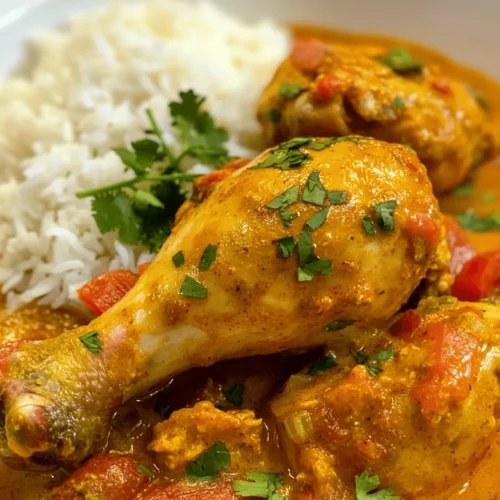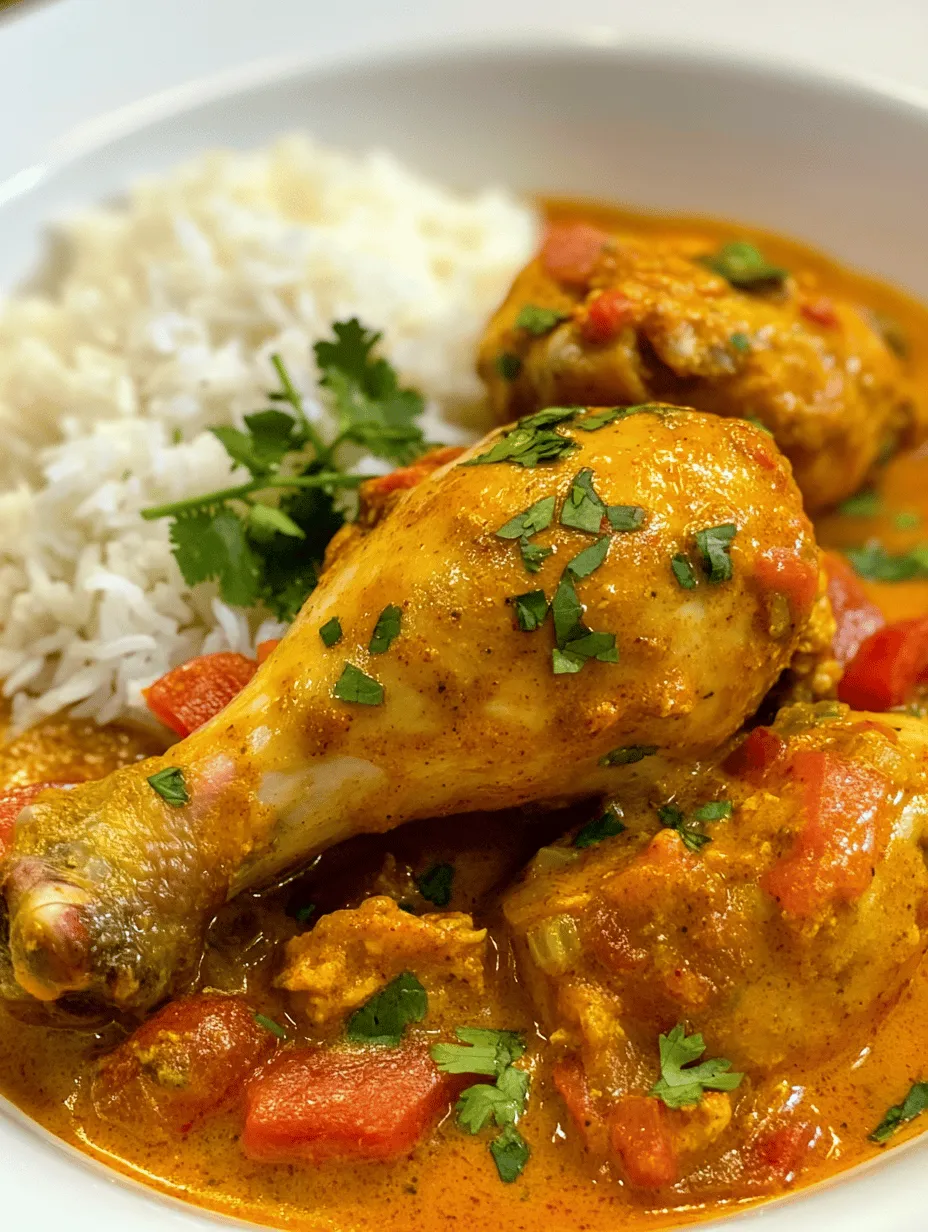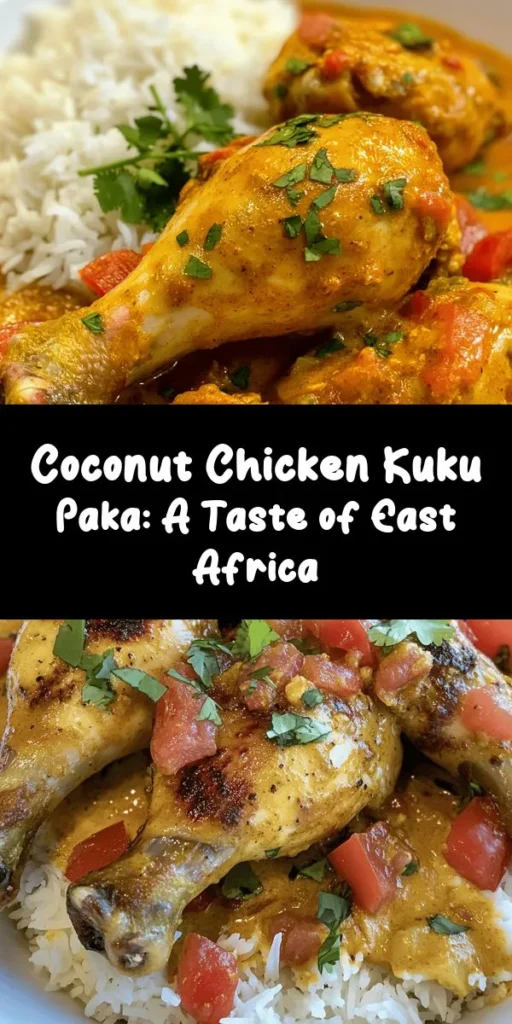Introduction
Kuku Paka is a traditional dish that holds a cherished place in East African cuisine, particularly in coastal regions such as Kenya and Tanzania. This delectable coconut chicken curry showcases the rich culinary heritage of the area, blending the influence of Indian spices with local ingredients to create a dish that is both comforting and exotic. The name “Kuku Paka” translates to “chicken in coconut” in Swahili, and indeed, coconut milk is a star player in this recipe, bringing creaminess and a subtle sweetness that perfectly complements the spices.
Coconut milk is deeply rooted in East African culinary traditions, not only for its flavor but also for its nutritional benefits. It provides healthy fats and essential nutrients, making it a staple in many households. The allure of Kuku Paka extends beyond its ingredients; it is a dish that resonates with diverse palates, appealing to both those who prefer mild flavors and those who enjoy a bit of heat. The combination of tender chicken, aromatic spices, and rich coconut milk creates a harmonious balance that is sure to delight anyone fortunate enough to enjoy this dish.
Understanding Kuku Paka
The history of Kuku Paka is as rich as its flavor. This dish is believed to have originated from the coastal regions of East Africa, where the influences of Indian, Arab, and indigenous cooking practices converge. The arrival of Indian traders and settlers brought with it a variety of spices and cooking techniques that have since been integrated into East African culinary traditions. This fusion is particularly evident in Kuku Paka, where the use of spices like curry powder and cumin reflects Indian influence, while the incorporation of coconut milk pays homage to local agricultural practices.
Across different countries in East Africa, Kuku Paka is enjoyed in various forms. In Kenya, it is often served with rice or chapati, making it a popular choice for both casual family meals and special occasions. In Tanzania, you might find it accompanied by ugali, a staple made from maize flour. Each region adds its own twist to the recipe, whether through the choice of spices or the cooking method, showcasing the versatility of this beloved dish.
Coconut itself plays a pivotal role in East African cuisine. Beyond its culinary applications, coconut is a source of nourishment, providing essential fats, vitamins, and minerals. The fruit is used in various forms—fresh, dried, or as milk—in numerous dishes, further highlighting its importance in the diet of many communities. Its creamy texture and natural sweetness make it an ideal complement to savory dishes like Kuku Paka, enhancing both flavor and nutrition.
Key Ingredients and Their Flavors
To create a truly memorable Kuku Paka, several key ingredients come together to form the foundation of this dish. Each component contributes unique flavors and textures, ensuring that every bite is a culinary delight.
– Chicken: The star of Kuku Paka is undoubtedly the chicken, typically prepared using drumsticks or thighs. These cuts are favored for their juiciness and ability to absorb flavors during the cooking process. Depending on personal preference, you can choose to leave the skin on for additional richness or remove it for a lighter dish. Marinating the chicken ahead of time is crucial, as it allows the spices and coconut milk to penetrate deeply, resulting in a more flavorful final product.
– Coconut Milk: The use of coconut milk is what sets Kuku Paka apart from other chicken curries. When selecting coconut milk, look for varieties that contain minimal additives and preservatives for the best flavor. Full-fat coconut milk will yield a richer sauce, while light coconut milk can be used for a healthier option. Regardless of the type, coconut milk brings a creamy texture and a subtle sweetness that balances out the spices.
– Spices: The spice blend is essential for achieving the signature flavor profile of Kuku Paka. Common spices include curry powder, cumin, coriander, turmeric, and chili powder. Curry powder adds warmth and depth, while cumin and coriander contribute earthy notes. Turmeric not only lends a vibrant yellow color but also offers anti-inflammatory benefits, while chili powder adds a touch of heat, allowing you to customize the spiciness to your liking.
– Aromatics: Aromatics like onion, garlic, and ginger play a crucial role in enhancing the dish’s overall flavor. Sautéing these ingredients releases their natural oils and intensifies their flavors, creating a robust base for the curry. The sweetness of the onions, the pungency of garlic, and the warmth of ginger work together to elevate the dish, ensuring that each bite is packed with flavor.
Step-by-Step Cooking Instructions
Now that we understand the delightful components that make up Kuku Paka, let’s dive into the step-by-step cooking instructions that will guide you in creating this flavorful dish.
1. Marinate the Chicken
The first step in preparing Kuku Paka is to marinate the chicken. This process is vital for maximizing flavor absorption and ensuring that the chicken remains tender during cooking. To create the marinade, combine coconut milk with a blend of spices including curry powder, cumin, coriander, turmeric, and a pinch of salt in a large bowl. Add the chicken pieces, making sure they are well-coated with the marinade. Cover the bowl and let it sit in the refrigerator for at least 30 minutes, though longer marination (up to several hours) will yield even better results.
2. Sauté the Aromatics
Once the chicken is marinated, it’s time to prepare the aromatics. Heat a large skillet or pot over medium heat and add a splash of oil. When the oil is hot, add finely chopped onions. Sauté the onions until they become translucent and start to caramelize, about 5-7 minutes. This step is crucial as it builds a flavor base for the curry.
Next, add minced garlic and grated ginger to the skillet. Continue to sauté for an additional 2-3 minutes, until the garlic is fragrant but not browned. The combination of sautéed onions, garlic, and ginger will create a rich and aromatic foundation for the curry.
3. Cook the Chicken
Once the aromatics are ready, it’s time to add the marinated chicken to the skillet. Cook the chicken pieces for about 5-7 minutes, turning occasionally to ensure even browning. The goal here is to sear the chicken and lock in its juices, which will enhance the overall flavor of the dish.
After the chicken has browned, pour in the remaining coconut milk and add additional spices if desired. Bring the mixture to a gentle simmer, cover the skillet, and let it cook for about 25-30 minutes, or until the chicken is fully cooked and tender. The coconut milk will thicken slightly, creating a luscious sauce that will envelop the chicken.
As you prepare this dish, the kitchen will be filled with enticing aromas that hint at the deliciousness to come. The interplay of spices, coconut milk, and tender chicken will create a culinary experience that transports you to the sunny shores of East Africa.
This introduction and the initial steps of preparing Kuku Paka set the stage for a delightful cooking experience, allowing you to immerse yourself in the vibrant flavors and rich traditions of East African cuisine.

The Process of Toasting Spices
Toasting spices is an essential technique in enhancing the overall flavor profile of Kuku Paka. When spices are toasted, their essential oils are released, intensifying their aroma and flavor. Begin by heating a dry skillet over medium heat. Once the skillet is hot, add your whole spices—typically cumin seeds, coriander seeds, and any others specified in your recipe. Stir them frequently for about 2-3 minutes until they become fragrant and slightly darker in color. This process not only develops a deeper flavor but also adds a subtle nuttiness to your dish.
The impact of toasting spices on Kuku Paka cannot be overstated. The vibrant, warm notes from the toasted spices will infuse the coconut milk and chicken, creating layers of flavor that elevate the dish. Remember to let the toasted spices cool before grinding them into a powder if your recipe calls for ground spices. This step is crucial for ensuring that the spices maintain their potency and do not lose their flavor during the cooking process.
Tips for Searing Chicken
Achieving a perfect golden-brown finish on your chicken is vital for both flavor and presentation. Start by patting your chicken pieces dry with paper towels. Moisture on the surface of the chicken can lead to steaming rather than searing, preventing that coveted golden crust. Season the chicken generously with salt and pepper just before placing it in the pan.
Heat a couple of tablespoons of oil in a heavy-bottomed skillet or Dutch oven over medium-high heat. Once the oil shimmers, carefully place the chicken pieces skin-side down in the skillet. Avoid overcrowding the pan, as this can lower the temperature and lead to uneven cooking. Sear the chicken without moving it for about 5-7 minutes until the skin is crispy and golden brown. Flip the chicken pieces and sear the other side for another 5 minutes.
The searing process not only adds flavor through the Maillard reaction (the browning that occurs when food is cooked at high heat) but also locks in juices, leading to tender, succulent chicken. After searing, you’ll be ready to move on to simmering the chicken in the coconut sauce, which will ensure it is cooked through and infused with all the delightful flavors.
Explanation of the Simmering Process
Simmering is a crucial step that allows the chicken to cook through thoroughly while absorbing the rich flavors of the coconut milk and spices. After searing, remove the chicken from the pan and set it aside. In the same skillet, add your toasted spices, garlic, ginger, and onions, sautéing them until fragrant and the onions are translucent.
Next, pour in the coconut milk and bring it to a gentle simmer. Return the chicken to the pan, ensuring it is submerged in the coconut sauce. Cover the skillet with a lid and simmer on low heat for about 20-30 minutes. This gentle cooking method helps keep the chicken juicy and tender.
To check for doneness, use a meat thermometer; the internal temperature should reach 165°F (75°C). If you don’t have a thermometer, make sure the juices run clear when the chicken is pierced with a knife. If desired, you can also add vegetables like bell peppers or green beans during the last 10 minutes of cooking for added nutrition and color.
Importance of Final Touches
Once the chicken is cooked through, it’s time for the final touches. Taste the sauce and adjust the seasoning as needed. A pinch of salt, a squeeze of lime, or a dash of chili powder can bring the entire dish to life. The balance of flavors is crucial, so feel free to experiment to find what works best for your palate.
If you prefer a thicker sauce, remove the lid and let it simmer for an additional few minutes, allowing it to reduce to your desired consistency. This step also intensifies the flavors, making your Kuku Paka even more delectable.
Serving Suggestions
Kuku Paka is best enjoyed with a variety of accompaniments that enhance its flavors. Serving it over a bed of fragrant basmati rice is a classic choice, as the rice absorbs the delicious coconut sauce, creating a harmonious meal. Alternatively, you can pair Kuku Paka with flatbreads such as chapati or naan, perfect for scooping up the sauce.
For a vibrant plate, consider adding a side of sautéed greens or a fresh salad. A cucumber salad with a zesty lime dressing can provide a refreshing contrast to the richness of the chicken and coconut milk.
When it comes to presentation, serving Kuku Paka in a large bowl garnished with fresh cilantro or parsley can elevate its appeal. You can also add lime wedges on the side for an extra burst of freshness. For beverages, consider pairing this dish with a chilled, fruity white wine or a refreshing coconut water to complement the tropical flavors.
Nutritional Information
Understanding the nutritional content of Kuku Paka can help you appreciate its health benefits. A serving of Kuku Paka typically contains around 350-450 calories, depending on portion sizes and specific ingredients used. The chicken provides a good source of protein, while the coconut milk contributes healthy fats, particularly medium-chain triglycerides (MCTs), which are known for their energy-boosting properties.
In addition to being delicious, the spices used in Kuku Paka, such as turmeric and ginger, offer anti-inflammatory benefits and can aid digestion. Coconut milk is also rich in vitamins C and E, as well as several B vitamins, making this dish not only flavorful but also nutritious.
For those with dietary restrictions, Kuku Paka is naturally gluten-free and dairy-free, making it a suitable option for various diets. You can modify the recipe by using skinless chicken or reducing the amount of coconut milk for a lighter version, while still retaining the dish’s integrity.
Cultural Significance of Kuku Paka
Kuku Paka holds a special place in East African culinary traditions, often served during family gatherings, celebrations, and communal feasts. In many cultures, sharing food is a symbol of hospitality and togetherness, and Kuku Paka embodies this spirit beautifully. The dish is often prepared for special occasions such as weddings, holidays, and family reunions, highlighting its importance in fostering connections among loved ones.
The communal nature of enjoying Kuku Paka resonates deeply with the values of sharing and hospitality in East African communities. It is a dish that brings people together, inviting laughter and conversation around the dining table. By preparing and sharing Kuku Paka, you partake in a rich cultural heritage that celebrates both flavor and togetherness.
Conclusion
Kuku Paka is more than just a meal; it’s a delightful journey through the rich culinary landscape of East Africa. The combination of tender chicken simmered in a fragrant coconut sauce, enhanced by toasted spices, creates a dish that is both comforting and exotic. Its cultural significance as a symbol of hospitality and community makes it a perfect choice for any gathering.
We encourage you to try making Kuku Paka at home to experience its unique flavors and the joy of cooking a traditional recipe that bridges cultures. Whether you’re serving it at a family dinner or sharing it with friends, Kuku Paka is sure to leave a lasting impression. Cooking is not just about nourishment; it’s about creating memories, sharing experiences, and celebrating the rich tapestry of our culinary heritage. Enjoy this delightful dish and let it inspire you to explore more flavors from around the world.



